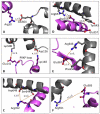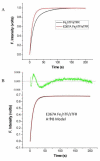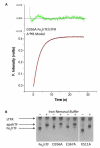Ionic residues of human serum transferrin affect binding to the transferrin receptor and iron release
- PMID: 22191507
- PMCID: PMC3267578
- DOI: 10.1021/bi201661g
Ionic residues of human serum transferrin affect binding to the transferrin receptor and iron release
Abstract
Efficient delivery of iron is critically dependent on the binding of diferric human serum transferrin (hTF) to its specific receptor (TFR) on the surface of actively dividing cells. Internalization of the complex into an endosome precedes iron removal. The return of hTF to the blood to continue the iron delivery cycle relies on the maintenance of the interaction between apohTF and the TFR after exposure to endosomal pH (≤6.0). Identification of the specific residues accounting for the pH-sensitive nanomolar affinity with which hTF binds to TFR throughout the cycle is important to fully understand the iron delivery process. Alanine substitution of 11 charged hTF residues identified by available structures and modeling studies allowed evaluation of the role of each in (1) binding of hTF to the TFR and (2) TFR-mediated iron release. Six hTF mutants (R50A, R352A, D356A, E357A, E367A, and K511A) competed poorly with biotinylated diferric hTF for binding to TFR. In particular, we show that Asp356 in the C-lobe of hTF is essential to the formation of a stable hTF-TFR complex: mutation of Asp356 in the monoferric C-lobe hTF background prevented the formation of the stoichiometric 2:2 (hTF:TFR monomer) complex. Moreover, mutation of three residues (Asp356, Glu367, and Lys511), whether in the diferric or monoferric C-lobe hTF, significantly affected iron release when in complex with the TFR. Thus, mutagenesis of charged hTF residues has allowed identification of a number of residues that are critical to formation of and release of iron from the hTF-TFR complex.
Figures





Similar articles
-
How the binding of human transferrin primes the transferrin receptor potentiating iron release at endosomal pH.Proc Natl Acad Sci U S A. 2011 Aug 9;108(32):13089-94. doi: 10.1073/pnas.1105786108. Epub 2011 Jul 25. Proc Natl Acad Sci U S A. 2011. PMID: 21788477 Free PMC article.
-
Inequivalent contribution of the five tryptophan residues in the C-lobe of human serum transferrin to the fluorescence increase when iron is released.Biochemistry. 2009 Apr 7;48(13):2858-67. doi: 10.1021/bi8022834. Biochemistry. 2009. PMID: 19281173 Free PMC article.
-
The unique kinetics of iron release from transferrin: the role of receptor, lobe-lobe interactions, and salt at endosomal pH.J Mol Biol. 2010 Feb 12;396(1):130-40. doi: 10.1016/j.jmb.2009.11.023. Epub 2009 Nov 13. J Mol Biol. 2010. PMID: 19917294 Free PMC article.
-
Transferrin-mediated cellular iron delivery.Curr Top Membr. 2012;69:3-35. doi: 10.1016/B978-0-12-394390-3.00001-X. Curr Top Membr. 2012. PMID: 23046645 Free PMC article. Review.
-
Kinetics of iron release from transferrin bound to the transferrin receptor at endosomal pH.Biochim Biophys Acta. 2012 Mar;1820(3):326-33. doi: 10.1016/j.bbagen.2011.06.003. Epub 2011 Jun 15. Biochim Biophys Acta. 2012. PMID: 21699959 Free PMC article. Review.
Cited by
-
Structure and dynamics of drug carriers and their interaction with cellular receptors: focus on serum transferrin.Adv Drug Deliv Rev. 2013 Jul;65(8):1012-9. doi: 10.1016/j.addr.2012.11.001. Epub 2012 Nov 23. Adv Drug Deliv Rev. 2013. PMID: 23183585 Free PMC article. Review.
-
Biochemical and structural characterization of recombinant human serum transferrin from rice (Oryza sativa L.).J Inorg Biochem. 2012 Nov;116:37-44. doi: 10.1016/j.jinorgbio.2012.07.005. Epub 2012 Jul 11. J Inorg Biochem. 2012. PMID: 23010327 Free PMC article.
-
Point Mutations in TbpA Abrogate Human Transferrin Binding in Neisseria gonorrhoeae.Infect Immun. 2022 Nov 17;90(11):e0041422. doi: 10.1128/iai.00414-22. Epub 2022 Nov 2. Infect Immun. 2022. PMID: 36321833 Free PMC article.
-
Structure-based mutagenesis reveals critical residues in the transferrin receptor participating in the mechanism of pH-induced release of iron from human serum transferrin.Biochemistry. 2012 Mar 13;51(10):2113-21. doi: 10.1021/bi3001038. Epub 2012 Mar 1. Biochemistry. 2012. PMID: 22356162 Free PMC article.
References
-
- Zak O, Aisen P. Nonrandom distribution of iron in circulating human transferrin. Blood. 1986;68:157–161. - PubMed
-
- Lawrence CM, Ray S, Babyonyshev M, Galluser R, Borhani DW, Harrison SC. Crystal structure of the ectodomain of human transferrin receptor. Science. 1999;286:779–782. - PubMed
-
- Mason AB, Byrne SL, Everse SJ, Roberts SE, Chasteen ND, Smith VC, Macgillivray RT, Kandemir B, Bou-Abdallah F. A loop in the N-lobe of human serum transferrin is critical for binding to the transferrin receptor as revealed by mutagenesis, isothermal titration calorimetry, and epitope mapping. J. Mol. Recognit. 2009;22:521–529. - PMC - PubMed
Publication types
MeSH terms
Substances
Grants and funding
LinkOut - more resources
Full Text Sources
Other Literature Sources
Medical

